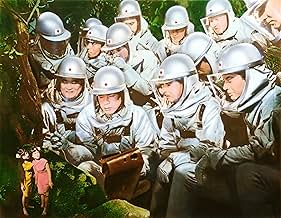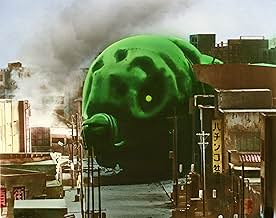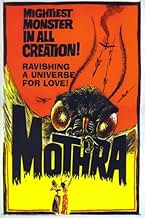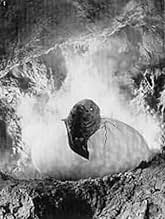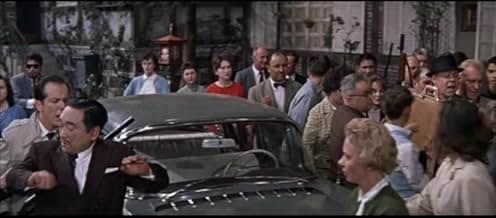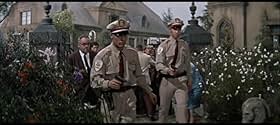Una expedición a la Isla Infantil descubre una población indígena y pequeñas hadas que adoran la deidad mítica de la isla. Conocido como Mothra, va al rescate de sus hadas cuando son secuest... Leer todoUna expedición a la Isla Infantil descubre una población indígena y pequeñas hadas que adoran la deidad mítica de la isla. Conocido como Mothra, va al rescate de sus hadas cuando son secuestradas por un empresario explotador.Una expedición a la Isla Infantil descubre una población indígena y pequeñas hadas que adoran la deidad mítica de la isla. Conocido como Mothra, va al rescate de sus hadas cuando son secuestradas por un empresario explotador.
- Dirección
- Guionistas
- Elenco
- Premios
- 2 nominaciones en total
- Shobijin (Twin Fairy)
- (as Yumi Ito)
- Shobijin (Twin Fairy)
- (as Emi Ito)
- Kurâruku Neruson
- (as Jerî Itô)
- Military Advisor
- (as Yoshibumi Tajima)
- Nelson's Henchman
- (as Hiroshi Iwamoto)
- Ship Survivor
- (escenas eliminadas)
Opiniones destacadas
1961's Mothra runs pretty evenly, allowing the story to breathe adequately before dishing out some modest mass destruction. The film's first acts, with scientists exploring Infant Island, remind me greatly of Skull Island from King Kong; the manner in which they use the fairies as a sideshow is not too far off from Kong either, only instead of unleashing a giant monkey's wrath, the fairies sing and summon a giant larva. It's weird stuff, but the film plays everything out with a straight face. This film ultimately sets the pattern for future incarnations of Mothra (you seriously can't have Mothra without the singing fairies, the larva, or without specific phases of attacks). As the original feature, however, the only formula this film adheres to is that of the classic monster picture, with a bit of adventure thrown in, and it's neat that way.
The story's pretty much outlined above; it is a well-structured plot with a cast of alright (and sometimes goofy) characters. With all the fairies and monsters on display, I always felt that Mothra was a grade more unbelievable than most other monster movies, but thanks to the film's earnest tone, it works as a fine and dandy fantasy (and it's pretty neat to see such fantasy being opposed by modern and ultramodern weaponry). The story touches upon a few themes concerning capitalism and greed, but is never overbearing.
This film uses solid, quality photography and editing. Acting is good from the original cast (but might be marred heavily by the English dubbing if you chose to watch it). Writing gets the job done pretty well. This production shows its age, but still uses fine-looking sets, props, and costumes. Special effects are a bit rough, but for its time, they are smashing. Music is not bad either.
No matter how silly or fantastic it gets, I have a soft spot for Mothra, especially in seeing her future clashes with Godzilla and other monsters. The first and most original Mothra film presents the basics of Mothra-lore, which in turn echoes parts of the original King Kong, and would stand proudly next to classic monster flicks like Godzilla. Fans of the genre should give this original film a rent.
4/5 (Entertainment: Good | Story: Pretty Good | Film: Good)
Here we see the debut of Mothra getting her own film, a character who would go onto be one of the most commonly seen creatures.
It tells the story of a rich businessman who kidnaps two tiny ladies from their native land to use in show business. In doing so Mothra was summoned to retrieve them using any means necessary even if it means the entire destruction of Tokyo in the process.
Mothra actually looks good for it's day, there is no man in a goofy suit as usual and Mothra in both infant and adult forms look far better than you'd expect.
The cast are less generic than usual, the lead is fairly comedic and the whole thing feels above average within this original kaiju film.
Certainly one of the better films of the series that I've seen thus far, but still highly niche.
The Good:
Some of the sfx are quite good for their day
Character development is better than usual
The Bad:
Still highly cheesy
A few weak points in the plot
Things I Learnt From This Movie:
Stowaways are not only not punished but they are given guns
A gigantic monster worm in a coccoon isn't newsworthy
The transitional phase for giant moths is a peanut
A greedy showman/explorer Clark Nelson (Jerry Ito) finds twin fairies on an island off Japan. He displays them on the Tokyo stage, where they sing what sounds like a lullaby. It is actually a telepathic distress call to their god and protector, Mothra, a giant caterpillar. Mothra comes to Tokyo, searching for the girls and Nelson, destroying most of the city in it's path. The chase goes from Tokyo to Newkirk City (I guess this is suppose to be a little real life hamlet just south of Yonkers!) What I really love about MOTHRA is that it has many things most other monster movies don't. The hero is a comical, older, tubby reporter, a sort of Japanese Lou Costello. The monster is actually pretty. In the Japanese version, there is some wonderful slapstick and odd humor. THese elements make this film so unique. Director Inoshiro Honda was best friends with more famous and more respected Japanese director Akira Kurosawa. Kurosawa loved Honda's monster movies and according to rumor, yearned to make one himself.
Nothing much to say about this one. I only knew Mothra as an adversary to Godzilla and was interested in seeing the film where he debuts and predates his epic fight with the lizard of destruction. It is a good story and gets to the heart of the Mothra myth with the singing fairies that summon him.
While maybe not as iconic as Godzilla, Mothra is a kaiju worthy of his own film series (which he has), and those interested in Toho's work really ought to check it out.
¿Sabías que…?
- TriviaThe Mothra larva was the largest costume Toho would create in the Showa era. The Mothra larva seen rampaging through Tokyo's neighborhood was about 7 feet tall and just over 31 feet long. Weighing about 265 pounds (120 kilograms), a total of eight actors were needed to perform and operate the Mothra larva.
- ErroresWhen Dr. Shinichi is showing the symbols he discovered in the cave to Senchan, you can see someone in black pants and shoes walking down the stairs behind Senchan's head.
- Citas
[the protagonists confront Nelson to return Mothra's fairies back to Infant Island]
Dr. Shinichi Chujo: I want you to stop this inhumanity and return them to their island.
Nelson's Henchman: Inhumanity? Ridiculous. Strictly speaking they're just scientific data.
Clark Nelson: Those fairies aren't human. They're merchandise.
- Créditos curiososIn the credits for the U.S. version, including promo material released by Columbia Pictures, Eurasian model Jerry Ito (who plays the villianous Mr. Nelson) is billed as "Jelly Ito."
- Versiones alternativasThe American Version also edited the birth of Mothra sequence, cutting out a good 40 seconds to make it more elaborate
- ConexionesEdited into La invasión de los astromonstruos (1965)
Selecciones populares
Detalles
Taquilla
- Total a nivel mundial
- USD 90
- Tiempo de ejecución1 hora 41 minutos
- Mezcla de sonido
- Relación de aspecto
- 2.35 : 1
Contribuir a esta página




